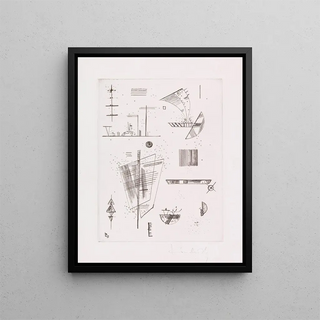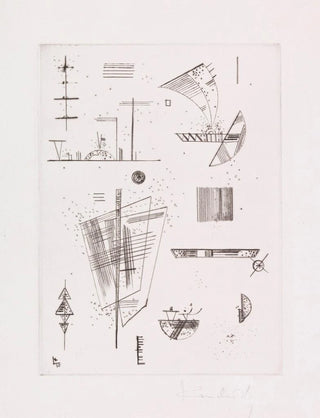Art print | First engraving for Cahiers d'Art Editions - Wassily Kandinsky


View from behind

Frame (optional)
First print for the Cahiers d'Art Editions - Wassily Kandinsky – Captivating Introduction
The "First print for the Cahiers d'Art Editions" by Wassily Kandinsky represents a fascinating gateway into the world of abstract art. Through this piece, the artist does not merely create an image; he offers a sensory experience that invites the viewer to immerse themselves in a universe where shapes and colors intertwine to evoke deep emotions. This work, emblematic of his avant-garde style, perfectly illustrates Kandinsky's desire to transcend the limits of figurative representation. Contemplating this print, one feels the vibrant energy that animates each line and nuance—a force that testifies to the artist's relentless pursuit of pure expression.
Style and uniqueness of the work
Kandinsky's style is characterized by bold abstraction and a daring color palette. In this print, geometric shapes blend with organic curves, creating a dialogue between the rational and the intuitive. Each element seems to dance on the paper, as if animated by an inner force. The composition, both balanced and dynamic, reveals a technical mastery that leaves no one indifferent. The shades of color, ranging from vivid hues to more subtle tones, contribute to an atmosphere oscillating between serenity and agitation. This duality is emblematic of Kandinsky's work, which sought to capture the essence of music through visual art. Indeed, he firmly believed that colors and shapes could evoke sounds and harmonies—a concept at the heart of this print.
The artist and his influence
Wassily Kandinsky, born in Russia in 1866, is often considered one of the pioneers of abstract art. His artistic approach, deeply influenced by his studies in music and philosophy, paved the way for many artistic movements of the 20th century. Kandinsky was able to combine theory and practice, proposing innovative concepts on color and form that continue to inspire contemporary artists. His work is not limited to mere aesthetics; it questions the relationship between art and

Matte finish

View from behind

Frame (optional)
First print for the Cahiers d'Art Editions - Wassily Kandinsky – Captivating Introduction
The "First print for the Cahiers d'Art Editions" by Wassily Kandinsky represents a fascinating gateway into the world of abstract art. Through this piece, the artist does not merely create an image; he offers a sensory experience that invites the viewer to immerse themselves in a universe where shapes and colors intertwine to evoke deep emotions. This work, emblematic of his avant-garde style, perfectly illustrates Kandinsky's desire to transcend the limits of figurative representation. Contemplating this print, one feels the vibrant energy that animates each line and nuance—a force that testifies to the artist's relentless pursuit of pure expression.
Style and uniqueness of the work
Kandinsky's style is characterized by bold abstraction and a daring color palette. In this print, geometric shapes blend with organic curves, creating a dialogue between the rational and the intuitive. Each element seems to dance on the paper, as if animated by an inner force. The composition, both balanced and dynamic, reveals a technical mastery that leaves no one indifferent. The shades of color, ranging from vivid hues to more subtle tones, contribute to an atmosphere oscillating between serenity and agitation. This duality is emblematic of Kandinsky's work, which sought to capture the essence of music through visual art. Indeed, he firmly believed that colors and shapes could evoke sounds and harmonies—a concept at the heart of this print.
The artist and his influence
Wassily Kandinsky, born in Russia in 1866, is often considered one of the pioneers of abstract art. His artistic approach, deeply influenced by his studies in music and philosophy, paved the way for many artistic movements of the 20th century. Kandinsky was able to combine theory and practice, proposing innovative concepts on color and form that continue to inspire contemporary artists. His work is not limited to mere aesthetics; it questions the relationship between art and






